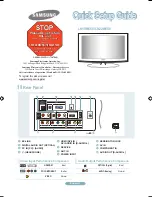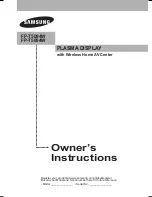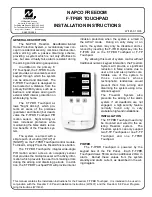
Using the TV’s Features
Chapter 3
17
Graphics contained within this publication are for representation only.
Parental Control
US V-Chip. . .
Canada V-Chip. . .
V-Chip Unrated/Exempt
View. . .
Front Panel Block
Channel Block. . .
Lock Parental Controls. . .
Press </> or OK to go to the sub-menu.
Press MENU to go to Main Menu.
Parental Controls
The
Parental Control
menu allows you to program your TV so that
children cannot see certain programs, channels, or use the front panel
controls. The
Parental Control
menu also involves software inside your
TV (referred to as V-Chip) which lets you program your TV so it won’t
display certain programs and movies based on violence, sex, or other
content you may believe children should not view. Once you block
programs, you or other adults can unblock programs by entering a
password to unlock video or enter the password to edit the features in
the
Parental Control
menu. By default, the software inside your TV is
turned “off,” so if you don’t want to use this feature, you can just
ignore it.
How V-Chip Works
The V-Chip software reads a code that most broadcasters send with programs. That code tells
the software the program’s age-based rating (TV-MA, TV-14, etc.) and content themes [(Violence
(V), Adult Language (L), etc.)]. If you have blocked the rating and/or content themes that the
program contains and the TV is locked and you tune to a program whose rating exceeds the
rating limit you set, you will receive a message telling you that the program is not approved for
viewing.
Broadcasters are not required to provide content themes, so programs received with no content
themes will only be blocked if you block their age-based rating and the TV is locked. You can
also block out programs that have been given a rating of Not Rated, and programs that are
considered unrated. The TV age-based ratings and content themes you can block are listed on the
next page.
US V-Chip Rating System
TV-MA (Mature Audience Only)
Specifically designed to be viewed by adults and may be
unsuitable for children under 17. It contains one or more of the following content themes:
crude indecent language (L), explicit sexual activity (S), or graphic violence (V).
TV-14 (Parents Strongly Cautioned)
Contains some material that many parents would find
unsuitable for children under 14. Parents are strongly urged to exercise greater care in
monitoring this program and are cautioned against letting children under the age of 14 watch
unattended. This program contains one or more of the following content themes: intensely
suggestive dialogue (D), strong coarse language (L), intense sexual situations (S), or intense
violence (V).
TV-PG (Parental Guidance Suggested)
Contains material that parents may find unsuitable for
younger children. Many parents may want to watch it with their younger children. The
program contains one or more of the following content themes: some suggestive dialogue (D),
infrequent coarse language (L), some sexual situations (S), or moderate violence (V).
TV-G (General Audience)
Most parents would find this program suitable for all ages. It
contains little or no sexual dialogue (D) or situations (S), no strong language (L), and little or no
violence (V).
TV-Y7 (Directed to Children 7 years and older)
Designed for children ages 7 and above. It
may be more appropriate for children who have acquired the developmental skills needed to
distinguish between make-believe and reality. Themes and elements in this program may
include mild fantasy violence (FV) or comedic violence, or may frighten children under the age
of 7.
TV-Y (All Children)
Themes and elements in this program are designed for a young audience,
including children from ages 2-6. It is not expected to frighten younger children.
16394790.03 Features
4/12/04, 6:33 PM
17
















































